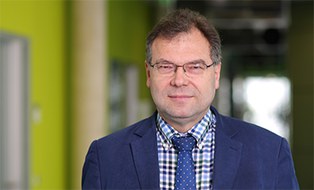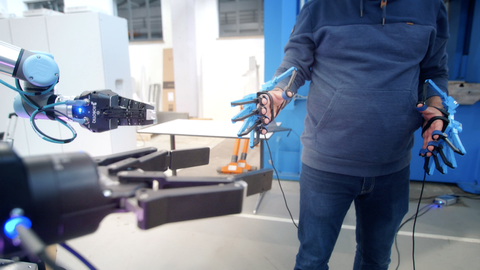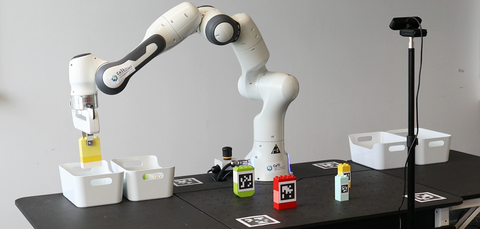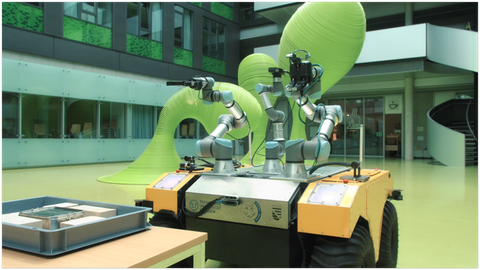Future Robotics Lab
Table of contents
Vision for society
In 2040, many robot-assisted products, services and solutions will support our society worldwide. Robots will revolutionize our world and automate many more everyday tasks than today. The Future Robotics Lab has set itself the task of researching methods, technologies and applications for this robotic revolution.
The robot revolution is driven by factors that span three dimensions: business models, technology and application areas. The new robot technology will form a first dimension of the future application of robots. Robots will collaborate with humans (cobotics), operate in groups (swarm robotics) and recharge their energy autonomously from batteries, green methanol or green hydrogen refueling stations (green robotics). The robots will work with modern tactile sensors (haptics) and sniffing sensors (sniffbots). Non-von Neumann robots will be built with innovative hardware and software architectures that will make robots much more resilient and flexible than they are today.
New business models for robotics will dominate the application markets. New robotic products will serve individuals (personal robotics), but robotic services will also be provided through shared infrastructures in a share economy (robotics as a service, RaaS) or purchased on a pay-per-use basis (pay-per-use robotics).
Finally, new applications will blossom in many application areas such as industry, agriculture and disaster management, and these application areas will form the third dimension of the robot world in 2040 (Robotics in application areas).
In 2030, the future robotics lab at TU Dresden will have researched many case studies of this vision, leading to new innovations in technology transfer to put Saxony in a leading position for the future robotics world of 2040.
Motivation and goals
The Future Robotics Lab (FuRoLab) at TU Dresden has set itself the task of bundling all competencies for robotics in the School of Engineering Sciences at TU Dresden.
Research mission
- Interdisciplinary collaboration on new research topics "future robotics".
- Establishment of working groups such as Industrial Robotics, Aerial/Space Robotics, Outdoor Robotics, Microrobotics
- Organization of keynote speeches by members
- Collaboration in joint DFG clusters
- Organizing research demonstrations in the "Smart Mobility Lab in Hoyerswerda"
- Research on new topics such as recycling and recultivation robotics, precision farming, construction and renovation robotics, factory in a box
Educational mission
- Development of new course profiles in existing Master's courses:
- MW-MA Mechatronics (MW): "Mechatronics for Robotics" profile
- INF-MA Distributed Systems Engineering (INF): "Software Engineering for Robots" profile
- Development for block internships in the "Smart Mobility Lab" in Hoyerswerda
- Support for existing robotics courses
- Lego Mindstorms in the Bachelor of Computer Science
- MW (Beitelschmidt)
Transfer mission
- Writing press articles about your own work
- Organizing a YouTube film platform
- Cooperation with Silicon Saxony, robotics working group
Exemplary fields of technology for research
Cobotics
Robots will cooperate with humans, protect their safety and know how to help them (attentive assistance). Working with a cobot will be as natural as working with an animal or a human employee.
Swarm robotics
While many robotic products and services will be based on stand-alone robots, by 2040 many services will be performed by swarms of robots that can be controlled from centralized operator dashboards, combine tasks on land, sea and air, and are able to meet and collaborate with other swarms of robots. Robot swarms are self-integrating systems that are able to adapt to new complex tasks and collaborate with other robot swarms. We envision that some robot swarms can also be rented as a service and that there will be companies that rent out robot swarms.
Green robotics
In the future, robotics should be completely free of fossil fuels, i.e. green. Robots are autonomous or semi-autonomous systems that can take care of their own energy needs. Innovative forms of batteries for renewable energy (hydrogen, sodium, rust, liquid air) will be used at different scales. Battery replacement, replenishment or recharging will be carried out autonomously. Robotic services will cooperate locally, operate on demand and according to a schedule that optimizes safety, robustness and energy consumption.
Microrobotics
Robots will also work in the nanometer range, e.g. in artificial organs or to monitor blood counts. For example, they will be used to measure insulin levels in different areas of the body so that an artificially controlled pancreas can ensure insulin secretion. Microrobots can also be used for diseases such as Parkinson's or epilepsy. Of course, these must be made of fully degradable materials and be supplied with renewable energy (energy harvesting).
Exemplary robot solutions in application areas
In 2040, many new markets for robots will have begun to flourish. In agriculture, the health of fields will be closely monitored for precision farming. In logistics, autonomous transportation robot swarm applications will increase, as well as serious drone applications, such as the transportation of important medicines, goods or documents. With such logistic mobility services, not only the last mile but also the penultimate mile of fast transportation services can be optimized. In disaster management, robot swarms and robots-as-a-service will play a major role in disaster prediction (forest fire and flood forecasting) and disaster management (firefighting, flood protection). Cobots will play an important role in industrial production, i.e. robots that protect human workers and work together with them. In the healthcare sector, robots will take over supportive care tasks.
A key milestone in the establishment of the Future Robotics Lab was the SNIFFBOT project for the identification and inspection of gas leaks using a telerobot, which ran from 2019-2021. In this project, several colleagues from the School of Engineering Sciences worked together to master the overall system.
Publications on SNIFFBOTS:
-
Sniffbots to the Rescue - Fog Services for a Gas-Sniffing Immersive Robot Collective
-
Report on the Saxon TG70 project
Contact us
 © 2017, Lucas Vogel
© 2017, Lucas Vogel
Prof. Dr. rer. nat. Uwe Aßmann
Send encrypted email via the SecureMail portal (for TUD external users only).



